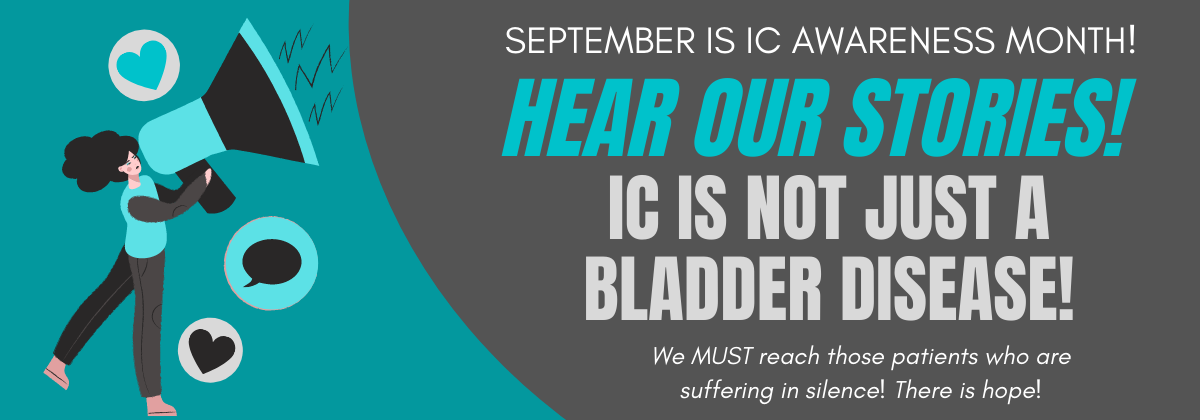Pain Management
The American Urology Association (Guidelines 14) states that “pain management should be an integral part of the treatment approach and should be assessed at each clinical encounter for effectiveness.” Why? The bladder, like any other part of the body, can generate pain so severe that patients require immediate medical care and treatment. Unfortunately, IC patients struggle to overcome the perception their bladder pain “isn’t that bad” or is very mild in nature. Of course, the pelvic floor muscles can also be a source of pain. The first published epidemiological study on IC in 1987 found that the pain of IC rated equivalent to that of cancer pain on the McGill Pain Scale. Similarly, the quality of life for some IC patients was rated equivalent to patients in end-stage renal failure.
Given the fact that patients suffering from cancer pain or kidney failure usually receive immediate care and attention, many IC patients also deserve prompt and compassionate pain care. The AUA suggests the use of a multimodal strategy to treat pain including the use of:
- urinary analgesics
- NSAIDS
- narcotic medications
- nonnarcotic medications
On Narcotic Medication
The AUA specifically does NOT DISCOURAGE the use of narcotic pain medication which may be required during periods of intense flares and discomfort. They state “It is clear that many patients benefit from narcotic analgesia as part of a comprehensive program to manage pain.” The use of pain medication, however, should NOT be considered or used as the only treatment. Other therapies that treat and, ideally remove, the cause of pain, should be explored, such as the treatment of painful trigger points or Hunner’s ulcers.
Pain care can be provided by the urologist, primary care provider or pain specialists. The challenge, of course, is that some care providers are simply uncomfortable providing prescriptions for opiate medication. If you, the patient, are not receiving adequate care for your pain, you can request a referral to a pain specialist.
On the Opiate Crisis & Physicians Refusing To Provide Medication
In 2016, the Centers for Disease Control issued new opiate prescribing guidelines that has resulted in many chronic pain patients being refused or discontinued from necessary pain medication. It is the tragedy of our generation due, sadly, the abuse of opiate medication and influence of drug cartels. If you are facing the loss of your pain medication, please consider these options:
Focus first on reducing the source of the pain so that you won’t need as much pain medication.
- If your pain is coming from your bladder wall, then focus on healing your bladder.
- Ask that Hunner’s lesions be treated if you have them.
- Follow the IC diet to avoid unnecessarily irritating your bladder and causing flares.
- Tight pelvic floor muscles need to be addressed. Do your physical therapy. Relax those muscles daily. Follow up on your physical therapy, if necessary. Muscle relaxants can help.
- Keep stress at a minimum.
- Avoid your well known flare triggers (i.e. long car rides, etc.)
- Consider other therapies, such as acupuncture.
Try OTC products
There are many OTC products that have the potential to help.
- AZO Bladder Pain Relief Tablets can help numb the bladder
- Pro-Sirona, Neuroquell and Tiger Balm are essential oil products that you can rub on your skin (not internally of course)
- Use heat or ice packs. Bodiheat heating pads can deliver heat for over 8 hours and work well for long car rides, work and/or traveling.
- Get massages to help keep your muscles relaxed
Work with, not against, your doctor
- Doctors are much more resistant about prescribing pain medication so you must make your case calmly and rationally.
- Remember that new doctors may not know how severe your pain may be. Tell them that the pain of IC has been related to the cancer pain. If available, bring a picture of your bladder.
- Bring the complete AUA Guidelines with you to appointments to show that the AUA supports pain care. It’s Guideline Statement 14!
- Don’t ask for pain medication first. You’ll look like a drug seeker. Tell them what your functional level is. Can you walk easily? Can you drive? Can you work? Can you shop or go to church? Show them how limited your life is and then ask “What can we do to improve my functionality?”
- Be willing to do a pain diary and track your symptoms.
- Be willing to sign a contract about your medication use.
- Always store your medication in a lock box so that it cannot be stolen.
- Understand that while the new pain regulations are harsh, they are trying to save
Consider Medical Marijuana
If medical marijuana is legal in your state or country, then it is worth considering. Research studies have found medical marijuana to help reduce pain and/or relax muscles. It’s also been found to improve the ability of pain medications to work. Learn more in the articles here:
- It’s time to consider medical marijuana for bladder and pelvic pain.
- Illinois MMJ law covers interstitial cystitis
Other Pain Resources & Groups
- The ICN Pain Resource Center
- Get the ICN Flare Management Guide when you sign up for the ICN E-Newsletter
- Depression and Interstitial Cystitis
- American Chronic Pain Association
- ACPA – Pain Management Tools
- 2017 Resource Guide For Chronic Pain Management
